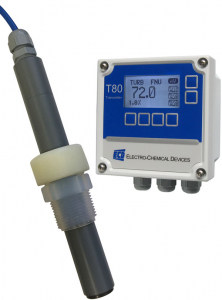Dual Function TR82 Analyzer Detects and Measures Turbidity in Either Clear Water or Wastewater

Ideal for Both Industrial Process and Municipal Water and Wastewater Treatment
Anaheim, CA—September 1—2021—With its precision nephelometric turbidity sensor designed for use in either municipal or industrial water and wastewater treatment systems, the versatile, next-gen TR82 Turbidity Analyzer from Electro-Chemical Devices (ECD) gives process and plant engineers a highly accurate and dependable solution to ensure that their treatment systems are performing at high efficiency and at the lowest cost to serve a wide range of needs.
The TR82 Turbidity Analyzer with its clear water sensor is designed for use in all phases of drinking water treatment and disinfection. It is ideal for monitoring ground water sources or surface water storage lakes, basins lagoons or ponds, as well as in the control of clear rinse water and in filter rupture or backwash monitoring systems.
The TR82 Analyzer’s suspended solids sensor supports both industrial process and municipal water and waste treatment. In food/beverage plants, for example, the TR82 Analyzer is ideal for mixing and blending, and in paper manufacturing it monitors filtrates. The TR82 also supports municipal wastewater activated and digested sludge treatments before effluent release.
The Triton TR82 uses the optical method for determining the turbidity. A light beam is directed into the sample where it is scattered by suspended particles in the water. The amount of scattering depends on the amount of material in the water, the wavelength of light, and the size and composition of the suspended particles.
The Triton TR82 features a near infrared LED light source and the 90-degree scattered light method in accordance with ISO 7027/EN 27027 to assure accurate turbidity values under standardized and comparable conditions. The TR82 response (and measurement data) depends on the size, shape and composition of the suspended particles.
The Triton TR82’s factory calibrated clear water and suspended solids sensors are available in four different standard measurement ranges: < 30 NTU, 0-1000 NTU, 0-4000 NTU and 0-5000 mg/l. In mud the available range is 5000-10,000 mg/l, and in sand the range is 50,000-100,000 mg/l. Custom ranges are available upon request.
Turbidity, the cloudiness or haziness of a water sample, is caused by particles suspended in the water, typically clay and silt. Since bacteria and viruses can be attached to these particles, turbidity monitoring with analyzers such as the TR82 with its dual sensor capability for both clear treated water and suspended solids monitoring has become a critical indicator of the overall water quality. In addition to protect the environment prior to treated effluent release back into the environment, water-based process plant technicians must test for turbidity to protect a wide range of plant and animal species from the hazards of contaminated water.
The TR82’s intelligent turbidity sensor technology stores the user’s chosen standard or factory custom calibration range, including self-diagnostics to alert technicians when adjustments or maintenance are necessary. These plug-and-play turbidity sensors connect seamlessly with ECD’s T80 Universal Transmitter. This transmitter comes with a choice of MODBUS, HART, 4 to 20 mA and/or relay outputs for multiple connection options to local programmable logic controllers (PLCs) and/or distributed control systems.
The T80 Transmitter can be configured as either a single or dual channel controller with one or two 4-20 mA outputs with MODBUS RTU and optional three alarm relays or HART 7 communication. The T80 Transmitter allows the turbidity or suspended solids measurement to be combined with other measurements using the ECD S80 pH, ORP, pIon, Conductivity or DO82 Dissolved Oxygen sensors and other ECD sensors.
Installing the TR82 Turbidity Analyzer is simple and straightforward with a choice of configurations available. A basic installation requires a 1-inch stand pipe for immersion service, or a PVC flow cell for an in line flow-through application, valve retractable, or a de-bubbler for micro air bubble applications.
